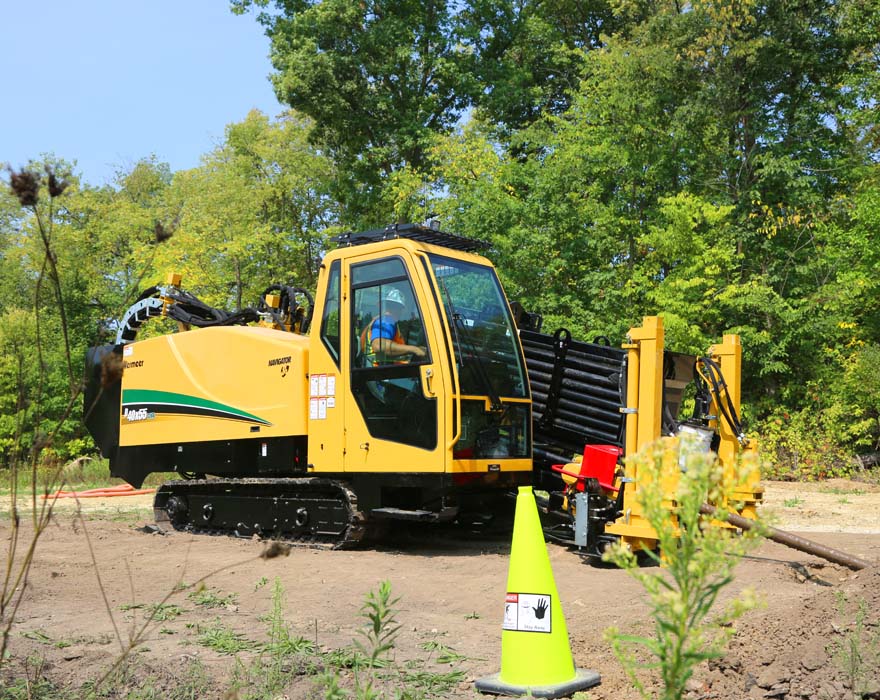Match bits and power to drilling conditions to help maximize jobsite effectiveness
Getting the job done right can depend on having the right tools, especially in rock drilling.
The structural integrity of a bore and the productivity and efficiency of rock drilling operations therein can depend on knowing your conditions and pairing the right machine and tooling to those conditions. Different projects are made up of different materials that can challenge both the effectiveness and steerability of a bore.
Variability challenges
The soil, sand and rock formations of projects that a drill operator will encounter can be highly variable. These different formations call for different tooling: a bit designed for compacted soil may not perform as well in cobbled or solid rock formations, and bits made for hard rock may not handle soil very well.
Conditions can change quickly, so it is important to be attentive to the conditions in which you’re drilling, and to apply the right amount of power to the right material with the right tooling and the right fluids for the job, according to Vermeer Product Specialist Joshua Spray.
“A big challenge can be transitioning out of dirt into rock, then back into dirt,” Spray said. “Once you put certain rock tooling, like an air hammer, into dirt, you may have a difficult time because an air hammer is not meant to drill through that kind of soil. It’s like pushing a telephone pole through the dirt.”
Planning your bore
To better understand the specific characteristics of the downhole material of a project — whether that’s rock, clay, sand or a combination — it can be helpful to have core samples tested by a laboratory in which the material’s composition and abrasivity can be tested, helping you to select the right tooling. Past experience with a specific region’s subsoil conditions and composition is also important to account for in selecting the right tooling.
“Knowledge of the conditions based off of past work done in an area can also be helpful in finding the right tooling for a job,” said Vermeer Lifecycle Product Manager Jason Zylstra. “Sometimes, you can get an idea of what your job will involve by understanding the conditions and area where a drilling has been done before. Local Vermeer representatives have a lot of knowledge about specific drilling conditions as well.”
Different tooling options
Boring through soil and sand, as well as rock — whether solid or cobbled — requires different tooling, which also can dictate the required pressure and cutting force of the selected bit. Some rock formations, like sandstone, are softer but have higher abrasivity, while others are harder but have lower abrasivity.
With rock up to 10,000 psi (13,558.2 Nm), a conventional drill combined with different tooling options can offer flexibility. The Armor® drilling system from Vermeer includes different bit options that are specifically designed for a range of common conditions an operator may encounter. The Lance™ bit features a scoop design but has carbide buttons and hardfacing that helps enable it to perform in both hard soils and cobble. On the other end of the spectrum is the Gauntlet™ bit. With carbide hardfacing and buttons to help minimize wear resistance and replaceable carbide-tipped teeth for cutting, the Gauntlet bit is more suited to drilling in medium rock, shale or caliche ground conditions.
Medium and harder rock formations, 10,000 psi (13,558.2 Nm) and up, may require one of several options beyond conventional drills and tooling. Air hammer, mud motor and dual rod (DR) machines like the Vermeer D40x55DR S3 Navigator® horizontal directional drill offer high pressure capacity and tooling that can handle both hard formations and those with high abrasivity.
Tricone bits can be well-suited for fractured rock and function well in a wide variety of conditions in a mud motor or dual rod
system. Polycrystalline diamond compact (PDC) bits use synthetic diamonds on the cutting edge that make them well-suited to
hard, solid rock but may not work as well in fractured conditions.
Matching the right bit type to your material and conditions is important, but so too is operating with the right speed and pressure to enable the selected bit to function optimally. “Regardless of the bit type you choose to operate, it is very important to know how to manage rotation speed and torque, as well as thrust, to help maximize your productivity on the jobsite,” Spray said.
Learn more about your options and find the right tooling for your next HDD job at borestore.com.
Vermeer Corporation reserves the right to make changes in product engineering, design and specifications; add improvements; or discontinue manufacturing or distribution at any time without notice or obligation. Equipment shown is for illustrative purposes only and may display optional accessories or components specific to their global region.
Please contact your local Vermeer dealer for more information on machine specifications.
Vermeer, the Vermeer logo, Armor, Lance, Gauntlet and Navigator are trademarks of Vermeer Manufacturing Company in the U.S. and/or other countries.
© 2019 Vermeer Corporation. All Rights Reserved.
